|
Fulks Run Section
Details From Stratigaphic Section  From Image 1 - Middle Tonoloway; bottom of measured section (Image 30)
From Image 1 - Middle Tonoloway; bottom of measured section (Image 30)Return to Mosaic |
|
Fulks Run Section
Details From Stratigaphic Section  From Image 1 - Middle Tonoloway; bottom of measured section (Image 30)
From Image 1 - Middle Tonoloway; bottom of measured section (Image 30)Return to Mosaic |
 From Image 5 - Middle Tonoloway. This is the first major packed biosparrudite in the section. Coarse to very coarse fining upward sequences of fossil fragmental limestone. Large scours visible. Fossils often large and easily identified, like the Favosites tabulate corals in the bottom picture. (Images 50, 32, 33, 34)
From Image 5 - Middle Tonoloway. This is the first major packed biosparrudite in the section. Coarse to very coarse fining upward sequences of fossil fragmental limestone. Large scours visible. Fossils often large and easily identified, like the Favosites tabulate corals in the bottom picture. (Images 50, 32, 33, 34)Return to Mosaic 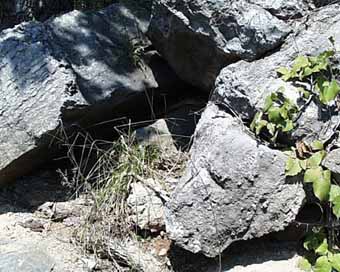 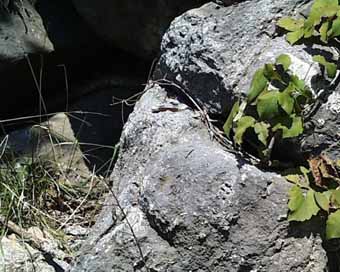
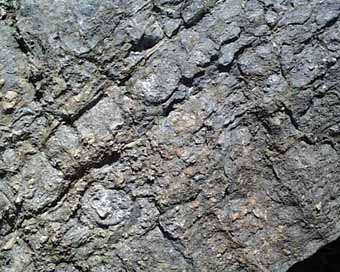
|
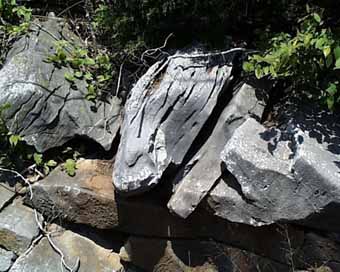 From Image 9 - Middle Tonoloway. Well sorted, packed biosparite (encrinite). This is a thick, amalgamated part of the outcrop. On weathered portions large scale cross bedding is readily visible. On the more freshly broken surfaces weathering has not gotten through the spar cement yet to reveal the bedding. (Images 35)
From Image 9 - Middle Tonoloway. Well sorted, packed biosparite (encrinite). This is a thick, amalgamated part of the outcrop. On weathered portions large scale cross bedding is readily visible. On the more freshly broken surfaces weathering has not gotten through the spar cement yet to reveal the bedding. (Images 35)Return to Mosaic  At the top the thick, amalgamated biosparite unit begins to form ribbon rock. Most other characteristics of the rock do not seem to change so it is not clear why it is forming ribbon here. At the top the thick, amalgamated biosparite unit begins to form ribbon rock. Most other characteristics of the rock do not seem to change so it is not clear why it is forming ribbon here.Return to Mosaic |
 From Image 10 and 11 - Middle Tonoloway. This is the second likely reef in the outcrop. Below, just above the drainage culvert, are well sorted, packed biosparites, but just up section is the layer of convolution/slumping, or what ever. I have tried to figure this out for years, but we will take it as a penecontemporaneous (at the time of, or shortly after, deposition) event. On top of it then is the tabulate/stromatoporoid layers. Tablate/strom associations are usually associated with the upper most (layer 4) of a reef structure, because they are strong enough to stand the pounding of the waves. (Images 49, 37, 38)
From Image 10 and 11 - Middle Tonoloway. This is the second likely reef in the outcrop. Below, just above the drainage culvert, are well sorted, packed biosparites, but just up section is the layer of convolution/slumping, or what ever. I have tried to figure this out for years, but we will take it as a penecontemporaneous (at the time of, or shortly after, deposition) event. On top of it then is the tabulate/stromatoporoid layers. Tablate/strom associations are usually associated with the upper most (layer 4) of a reef structure, because they are strong enough to stand the pounding of the waves. (Images 49, 37, 38)Return to Mosaic 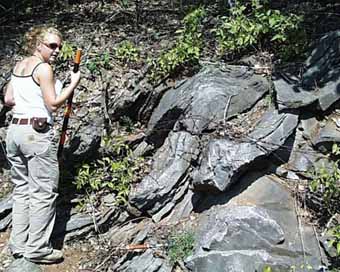 
In the image to the right are the stromatoporoids (NOT stromatolites). Hard to see, but are composed of fine concentric laminations of skeletal calcite, and not micrite. |
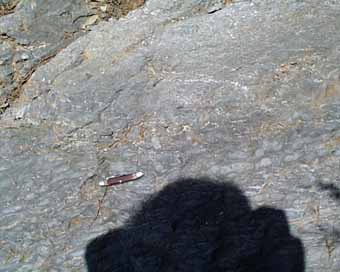 From Image 13 - Upper Tonoloway. It is difficult to see in the wide angle image 13, but the beds in the middle of the picture contained the two tidal channels we observed. And even the detailed picture to the right does not bring it out well. But just above the shadow (my hat) is the base of the upper scour, filled with mud pebbles and coarse fossil fragments. Below the scour the rock is heavily ribboned (you can see the nodular look), making it hard to sort things out, but there are some remains of algal laminates. (Images 39)
From Image 13 - Upper Tonoloway. It is difficult to see in the wide angle image 13, but the beds in the middle of the picture contained the two tidal channels we observed. And even the detailed picture to the right does not bring it out well. But just above the shadow (my hat) is the base of the upper scour, filled with mud pebbles and coarse fossil fragments. Below the scour the rock is heavily ribboned (you can see the nodular look), making it hard to sort things out, but there are some remains of algal laminates. (Images 39)
|